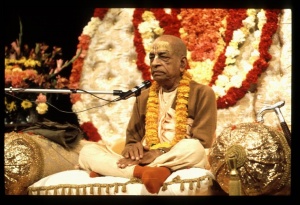CC Adi 7.112

A.C. Bhaktivedanta Swami Prabhupada
TEXT 112
- tāṅhāra vibhūti, deha,—saba cid-ākāra
- cid-vibhūti ācchādi’ tāṅre kahe ‘nirākāra’
SYNONYMS
tāṅhāra — His (the Supreme Personality of Godhead’s); vibhūti — spiritual power; deha — body; saba — everything; cit-ākāra — spiritual form; cit-vibhūti — spiritual opulence; ācchādi’ — covering; tāṅre — Him; kahe — says; nirākāra — without form.
TRANSLATION
“Everything about the Supreme Personality of Godhead is spiritual, including His body, opulence and paraphernalia. Māyāvāda philosophy, however, covering His spiritual opulence, advocates the theory of impersonalism.
PURPORT
It is stated in the Brahma-saṁhitā, īśvaraḥ paramaḥ kṛṣṇaḥ sac-cid-ānanda-vigrahaḥ (BS 5.1): “The Supreme Personality of Godhead, Kṛṣṇa, has a spiritual body which is full of knowledge, eternity and bliss.” In this material world everyone’s body is just the opposite—temporary, full of ignorance and full of misery. Therefore when the Supreme Personality of Godhead is sometimes described as nirākāra, this is to indicate that He does not have a material body like us.
Māyāvādī philosophers do not know how it is that the Supreme Personality of Godhead is formless. The Supreme Lord does not have a form like ours but has a spiritual form. Not knowing this, Māyāvādī philosophers simply advocate the onesided view that the Supreme Godhead, or Brahman, is formless (nirākāra). In this connection Śrīla Bhaktivinoda Ṭhākura offers many quotes from the Vedic literature. If one accepts the real or direct meaning of these Vedic statements, one can understand that the Supreme Personality of Godhead has a spiritual body (sac-cid-ānanda-vigraha (BS 5.1)).
In the Bṛhad-āraṇyaka Upaniṣad (5.1.1) it is said, pūrṇam adaḥ pūrṇam idaṁ pūrṇāt pūrṇam udacyate. This indicates that the body of the Supreme Personality of Godhead is spiritual, for even though He expands in many ways, He remains the same. In the Bhagavad-gītā (BG 10.8) the Lord says, ahaṁ sarvasya prabhavo mattaḥ sarvaṁ pravartate: “I am the origin of all. Everything emanates from Me.” Māyāvādī philosophers materialistically think that if the Supreme Truth expands Himself in everything, He must lose His original form. Thus they think that there cannot be any form other than the expansive gigantic body of the Lord. But the Bṛhad-āraṇyaka Upaniṣad confirms, pūrṇam idaṁ pūrṇāt pūrṇam udacyate: “Although He expands in many ways, He keeps His original personality. His original spiritual body remains as it is.” Similarly, elsewhere it is stated, vicitra-śaktiḥ puruṣaḥ purāṇaḥ: “The Supreme Personality of Godhead, the original person [puruṣa], has multifarious energies.” And the Śvetāśvatara Upaniṣad declares, sa vṛkṣa-kālākṛtibhiḥ paro ’nyo yasmāt prapañcaḥ parivartate ’yaṁ dharmāvahaṁ pāpanudaṁ bhageśam: “He is the origin of material creation, and it is due to Him only that everything changes. He is the protector of religion and annihilator of all sinful activities. He is the master of all opulences.” (Śvet. Up. 6.6) Vedāham etaṁ puruṣaṁ mahāntam āditya-varṇaṁ tamasaḥ parastāt: “Now I understand the Supreme Personality of Godhead to be the greatest of the great. He is effulgent like the sun and is beyond this material world.” (Śvet. Up. 3.8) Patiṁ patīnāṁ paramaṁ parastāt: “He is the master of all masters, the superior of all superiors.” (Śvet. Up. 6.7) Mahān prabhur vai puruṣaḥ: “He is the supreme master and supreme person.” (Śvet. Up. 3.12) Parāsya śaktir vividhaiva śrūyate: “We can understand His opulences in different ways.” (Śvet. Up. 6.8 (CC Madhya 13.65, purport)) Similarly, in the Ṛg Veda it is stated, tad viṣṇoḥ paramaṁ padaṁ sadā paśyanti sūrayaḥ: “Viṣṇu is the Supreme, and those who are actually learned think only of His lotus feet.” In the Praśna Upaniṣad (6.3) it is said, sa īkṣāṁ cakre: “He glanced over the material creation.” In the Aitareya Upaniṣad (1.1.1-2) it is said, sa aikṣata—“He glanced over the material creation”—and sa imāl lokān asṛjata—“He created this entire material world.”
Thus many verses can be quoted from the Upaniṣads and Vedas which prove that the Supreme Godhead is not impersonal. In the Kaṭha Upaniṣad (2.2.13) it is also said, nityo nityānāṁ cetanaś cetanānām eko bahūnāṁ yo vidadhāti kāmān: “He is the supreme eternally conscious person, who maintains all other living entities.” From all these Vedic references one can understand that the Absolute Truth is a person and that no one can equal or excel Him. Although there are many foolish Māyāvādī philosophers who think that they are even greater than Kṛṣṇa, Kṛṣṇa is asamaurdhva: no one is equal to or above Him.
As stated in the Śvetāśvatara Upaniṣad (3.19), apāṇi-pādo javano grahītā. This verse describes the Absolute Truth as having no legs or hands. Although this is an impersonal description, it does not mean that the Absolute Personality of Godhead has no form. He has a spiritual form that is distinct from the forms of matter. In this verse Caitanya Mahāprabhu clarifies this distinction.